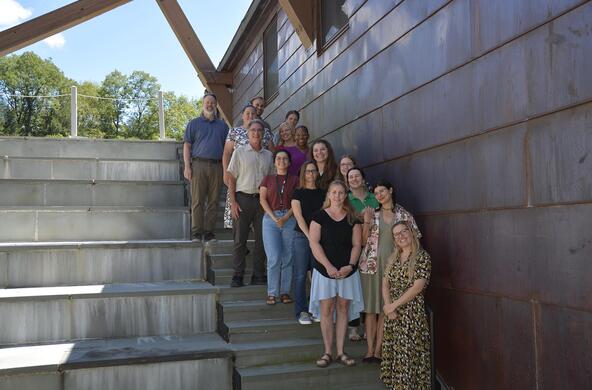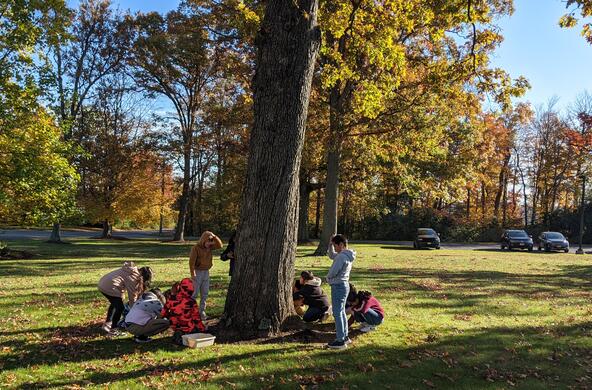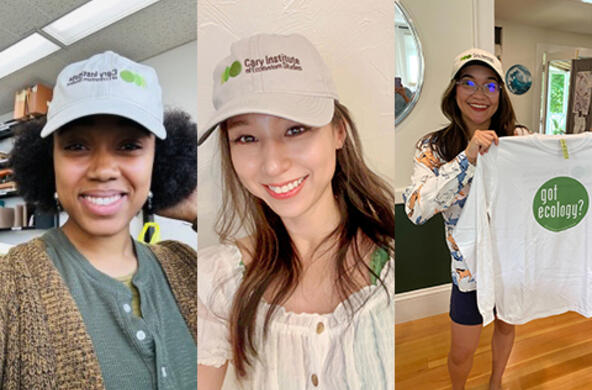Winter offers children a wonderland of ways to meet nature up close, with few supplies required. At first, a parent might think, "Isn't much of the natural world absent in the Northeast during the winter?" Well, yes, but according to educators at Millbrook's Cary Institute of Ecosystem Studies and New Paltz's Mohonk Preserve, there's plenty to do and discover, and it includes embracing that absence.
Jennifer Rubbo, ecology education program specialist at Millbrook's Cary Institute of Ecosystem Studies, points out: "You can completely see the landscape — rolling hills, streams, because nothing is blocking the view."
"And the geology!" she said. "You can see the rocks. They aren't covered by vegetation."
Appreciating trees that look like wiry sculptures, now that their leaves are gone, is a special opportunity winter offers. Using the institute's grounds as an example, Rubbo said, "On the lowlands down by the (Wappingers) Creek, the sycamore trees really stand out."
Winter is the only time to fully appreciate the white branches of those tall trees.
Cathy Shiga-Gattullo, educator for interpretation and visitor engagement at the Mohonk Preserve in New Paltz, mentioned additional sights available only during the colder months. This is the best time to spot bluebirds and cardinals, she said. They prefer it colder and so tend to move farther north of the mid-Hudson as the weather warms.
"The tufted titmouse is one of the cutest birds," she added, and you see more of them in winter.
Even the sound of winter is different, she said. On the one hand, children can notice "how quiet the winter woods can be." On the other hand, "It's a great time to listen to nature, when road sounds are insulated by snow."
The timing was perfect for a recent family-friendly winter walk led by Andrea Caruso, an ecology education program assistant at the Cary Institute. The group of about 40 could clearly spot animal tracks, because there was snow on the ground. And it had fallen recently enough that the prints hadn't been obscured by those of humans.
“A lot of animals we think might have gone off are actually present, so we tried to look for evidence,” Caruso said. “The squirrel is an animal that kind of bounces and lands on two feet, then brings the front feet down and jumps again. The four prints are all in one group. Of course deer have hooves, but another clue is that in the case of animals like deer and coyotes, the prints are spread out. They walk instead of jump.”
Shiga-Gattullo said that while the claws or nails of dogs and other local animals are clearly visible along with their paw prints, the claws of cats are not, because they are able to retract them. Even preschoolers enjoy using that clue to spot cat prints in the snow.
She added that there’s fun to be had with human footprints, too. Children of preschool age and up can have fun playing Follow the Leader, attempting to stay within the footprints of the walker who preceded them.
Snow can also serve as a canvas for artists of any age. “Use sticks or fallen pine needles or stones to make a design on the background of white snow,” Shiga-Gattullo suggested.
On the nature walk Caruso led, she showed families how to follow up the long distance view of a tree and its bare branches, by moving in closer for a bark rubbing. Sheets of tracing paper are required. Charcoal is often used to create a rubbing. Caruso supplied the children and their families with large-sized crayons with their paper wrappings removed.
By holding the paper right up against the bark, then covering it with up and down strokes of the crayons held sideways, children can watch a distinct pattern emerge. Besides displaying the resulting art works, families can use the clues yielded by that activity to identify the type of tree, even when the identifiers most people use — its leaves — are missing. Young outdoor detectives can match their traced bark designs with examples printed in a field guide.
Caruso and Shiga-Gattullo both suggested bringing black fabric outside during a snow fall and, with a magnifying glass, examining single flakes that have landed on it.
“If you watch for a while, you can see their diversity of shape and size,” Caruso said.
Before winter walks she has led at the Institute, she has supplied children with the materials to cut out circles of cardboard, glue black felt to them and attach a ribbon long enough so they can wear their creations around their necks as they walk outside during a snow fall. If it’s not snowing, she said, a child can stand under a tree while someone gently shakes a branch, causing snow to fall on the felt.
She warned that in that case, “many flakes will fall at once. You don’t get to see that beautiful six-sided shape, but it’s still a lot of fun to look at (under a magnifier).”
Shiga-Gattullo said that, unlike most of her friends and neighbors, she does not clean up her garden as winter approaches, but waits until spring. She said that with seeds contained in everything from weeds to the sunflowers many people include in their gardens, an uncleared plot can offer a view of animal customers dropping by for the winter harvest.
She said that winter’s early nightfalls bring a special gift.
“Stargazing in winter is a great thing, because there are easily recognizable constellations, like Orion, and crisp views,” due to the dry winter weather on nights when there is no precipitation. She added that because it gets dark early, children have the opportunity to look up at the night sky before bedtime.
Exposing children to the adventure and beauty of the outdoors can affect their lives from that point on. Caruso grew up in a garden apartment setting in Westchester County, but regularly visited an aunt and uncle in the Capitol region, who lived closer to woods.
She acknowledges that she has always had a love of science. Likewise, teaching has always attracted her, “because I love to encourage people to look more closely at things.” But she said those visits upstate also played a part in affecting her habits as an adult.
When her aunt took her walking in the woods, “she would encourage me to stop once in a while and take a good look.” She remembers doing just that, at about the age of 7, as she stood with her aunt and watched a deer move near them. She can feel the effect of that day on her lifelong habits.
“The serenity of it helped inspire me to do that kind of thing on a regular basis.”






